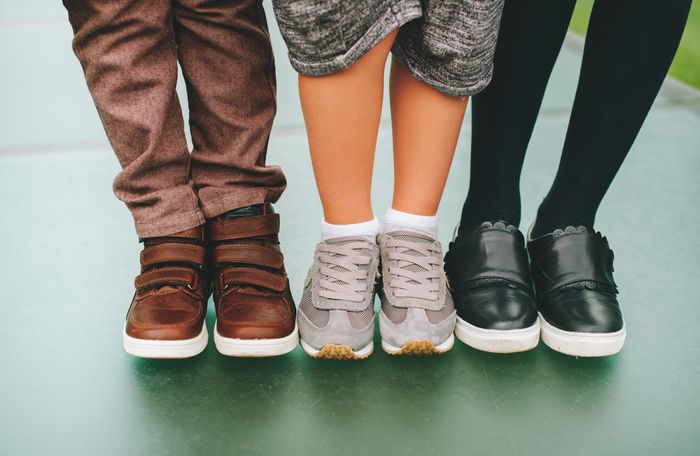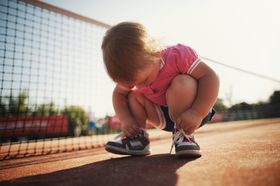Which Shoe Fabrics Are Best for Children’s Feet?
Updated July 27, 2023.

Choosing the right material for your children's shoes is a critical decision that parents and guardians face. While comfort and safety are the two main factors that influence this choice, there's more to it than meets the eye.
To help us unravel this topic, we turned to Natasha Hogan, the author of Pregnancy and Infertility, a passionate Podiatrist with specialty training in children’s podiatry, biomechanics, and over 20 years of experience in the healthcare industry. Having worked with defence personnel, sports professionals and in hospitals, it’s unlikely there is an injury or condition she hasn’t dealt with.
Accommodating Sensitive Skin in Children's Footwear
The material of shoes plays a pivotal role in shaping the overall experience of children wearing them. Young ones, especially those grappling with extra sensory processing challenges, might find new sensations daunting. Therefore, it is essential to heed a child's instinctive responses. If they exhibit discomfort or distress when wearing certain shoes, it may signal the need for a better-suited pair designed with sensitive skin in mind.
Benefits of Natural Textiles
Among the ideal materials for children's shoes are wool, cotton, and denim. Wool is highly regarded for its hypoallergenic properties, offering insulation and temperature maintenance while wicking away moisture. It is also lightweight, biodegradable, and machine-washable, making it a practical choice for children's footwear.
Cotton, another favourable option, delivers soft and lightweight comfort, coupled with the capability to easily release dirt and germs. However, it's worth noting that a claim of 95% organic cotton doesn't ensure a completely chemical-free material; therefore, parents must pay keen attention to labels.
Denim, a robust cousin of cotton, offers durability and structure retention, though it's essential to avoid prolonged use, as growing feet require space and mobility.
The Advantages of Leather
Leather shoes, despite being often overlooked, offer immense benefits for children. The complex, tri-layered structure of this type of shoe leather – composed of a breathable and waterproof grain layer, a fibrous tissue layer, and a cotton backing—sets it apart from other materials. The density and sturdiness of these layers make leather shoes durable, easy to clean, and, critically, breathable, reducing bacterial growth.
Furthermore, leather shoes, particularly high-top designs, can assist children in learning to walk by fortifying the connection between their brain and muscles, especially if there is an extra need for this eg. muscle weakness and nerve connections. This sensory engagement can potentially accelerate their development, underlining the benefits of leather-soled shoes.
» Learn how to take care of leather footwear properly
Synthetic vs. Genuine Leather
While synthetic materials like hemp and bamboo might appear more sustainable or economical, they also pose challenges. These materials, including synthetic leather, often undergo chemical treatments, raising the risk of skin irritation. Since children under three have particularly sensitive skin, exposure to these irritants could potentially lead to complications like eczema and psoriasis.
Environmental Concerns
The high energy consumption involved in converting natural materials into textiles, like bamboo, presents a noteworthy environmental concern. Cork, despite being more natural, falls short as a practical option for children's shoes due to its vulnerability to wet conditions.
Materials to Avoid
The downside of synthetic materials extends beyond mere irritation risks. Synthetic shoes, while cheaper initially, fail to hold their shape as well as premium materials like leather and wear out more rapidly. As such, parents might find themselves frequently replacing these cost-effective shoes, negating the initial savings.
When sourcing shoes for your children, it is prudent to avoid certain materials like acrylic and particular plastics, specifically types three and seven, due to their associated health risks. Acrylic fibres, for instance, have been linked to cancer in animal studies, while certain plastics might contain BPA, a chemical connected with reproductive issues.
» Here's how you should wash your kids' shoes
Footprints to a Better Future
When it comes to children's footwear, the mantra of 'quality over quantity' resonates profoundly. It's worth investing in a few pairs of high-quality shoes each year rather than multiple cheaper pairs. This approach not only offers superior long-term value but also ensures that the shoes are safe and comfortable for your child's rapidly growing feet.
By diligently reading labels and making informed decisions, you can opt for shoe materials that are both beneficial for your children and kind to the environment. Despite the overwhelming array of choices, the priority should always anchor on the health, comfort, and development of your child.





